Bill Young 2012
(John Feder photo)
The Story of BILLY YOUNG Timelines
2006
3 September. I first hear the story of Billy Young from a relative who visits my bookstall at Canberra’s Old Bus Depot Market, and tuck it away at the back of my mind and the "Ideas" file.
2007
September. Nearing the end of writing Captain Cook’s Apprentice, it becomes ever more important to find Bill Young and talk to him on the phone. I write more about this in the introduction to the book.
4 December. I visit him in Sydney and record the first of more than 60 interviews on Billy’s childhood, growing up around Sydney’s Paddy’s Market during the Depression, his enlistment, wartime experience in Malaya, capture and imprisonment as a POW. Billy was not yet 20 when he returned to Australia at the end of the war.
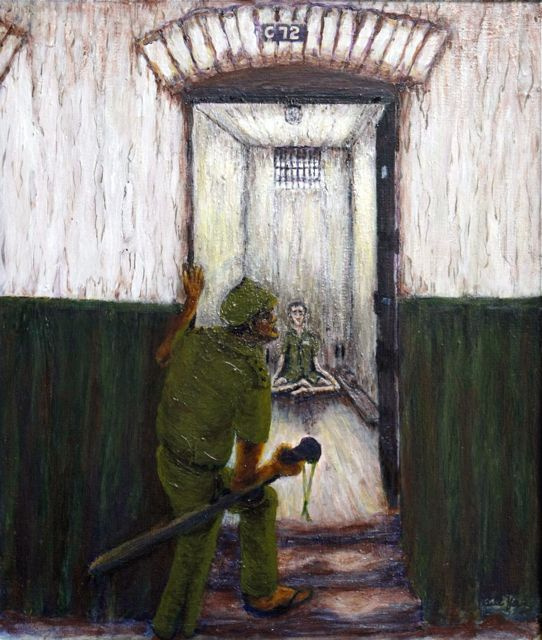
2008
January. The long preliminary stages begin to transcribe the interviews with Billy, research the subject at the Australian War Memorial, the National Library of Australia, contacts with military historians and wide reading into the authoritative sources. At the same time I’m also completing the editing and production of Captain Cook’s Apprentice with the publisher, Penguin Books.
October. The ACT Arts Council generously awards me a grant to assist with the necessary travel costs and to help fund Billy's writing time.
Cell C72, Outram Road Prison, by Bill Young
2009
25 January. At 6.25 in the morning I sit at the laptop on the dining table and write the first words of the first chapter of The Story of BILLY YOUNG. See them on Billy's home page. They’ve been in my head for months. The second paragraph is the hard one. The author is back in harness and the discipline of writing a minimum 200 words every day – and so adding one more page to the pile.
April. With two and a half chapters written, I make a research trip to Singapore and Borneo, travelling to Sandakan POW camp for Anzac Day, Ranau and Labuan with a party organised by the historian Lynette Silver, and then on to Kuching where Billy was sentenced to four years solitary confinement at Outram Road Prison, Singapore...
June. Back home, and after a break to celebrate the birth of our new grand-daughter on 31 May, it’s back to the desk and the slog with words.
So a whole year passes, interviewing, going over the work with Billy and adding to the story where the writing has jogged his memory, reading, checking, recording, transcribing, composing … and 100,000 words later…
2010
13 July. I start the last chapter of the book, and about a fortnight afterwards I find myself typing THE END. And I have the little weep I always have when the last words have been written down and the story has been told.
19 August. Work starts on the rewrite, pulling the manuscript to pieces, cutting, tightening, revising, checking and putting it together again. Patrick White used to call this part of the creative process ‘oxywelding.’
26 October. Finished. At last! I give the final pages to my Japanese friend, Shuji Yamazaki, a fellow trader at the market. Shuji has given much kind advice on Japanese words and culture, and read the whole of what I know must have been a confronting manuscript. I give myself a month of tweaking and fiddling before letting go, and then...
22 November. I contact the Penguin publisher Bob Sessions and send him the proposal.
6 December. Bob loves the idea, and offers a contract and a good advance which I happily accept. I send him the typescript by email for a long Christmas read.
2011.
31 January. Email from Bob, ‘Should we be drawing up a contract now?’ You bet!
February. The publishing contract is negotiated ... a question here, an agreement there ... and make sure you read and understand every clause.
28 March. Contracts are signed, and a publication date is set for August 2012. A long time to wait! But much to do with checking, revising, discussing titles, sending the manuscript out to specialist readers, completing the Chapter Notes, Acknowledgments and References, sourcing possible photos – and incidentally starting to think about a new project.
July. Lots of continuing discussion on the title. I've always called it Billy the Kid, because that's what the older POWs who looked after Bill called him. But the publishers rightly think a book with such a title will end up in the shops among the westerns ... with the Cowboys and Indians. One thought is Young Billy, a play on his name. But I already have a book Young Digger, and I don't want to be though unimaginative on the subject of titles. We keep brain-storming. One thing we are all agreed on is the sbtitle: ...A Teenager in Changi, Sandakan and Outram Road. It tells it all.
December. The Penguin editor Anne Rogan starts work on the detailed copy editing.
2012
6 January. The first three edited chapters arrive electronically for me to go through, correct, revise and amend as necessary. Anne has done a terrific job. There are some confusions and clarifications in the text to be attended to, punctuation and grammar to be sorted, and a few insertions of my own to be made. A few things that I would like to leave as they are. “Track Changes” has to be mastered on the computer. But essentially the text stands as written and my voice is still heard. By consensus we've come to the view that the best title will be The Story of BILLY YOUNG, with the subtitle as agreed. Essentially it will be known as Billy Young, or even just plain Billy. Which was always my second choice.
19 January. The first three chapters, together with the four draft maps I've done are sent back to Anne with my comments.
7 February. The next six chapters arrive. As we are hoping to go to the typesetter by the end of February the skates will have to be put on.
9 February. I post the first advance publicity pages for The Story of BILLY YOUNG on my website. Here's hoping!
THE COUNTDOWN TO THE NEW BOOK STARTS NOW!
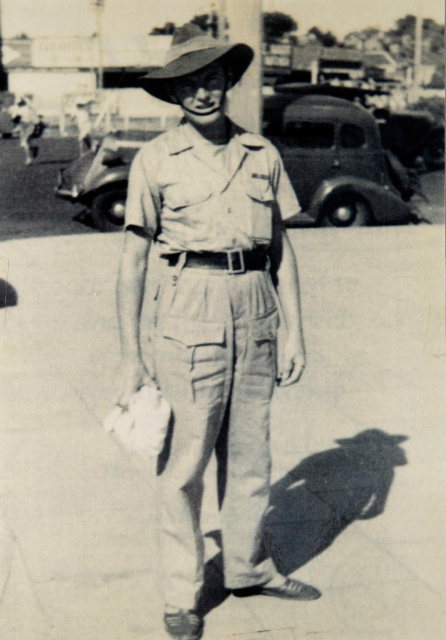
15 February. I finish Chapters 4 to 9 and return them to Anne just as the last six chapters arrive with the Acknowledgments, End Notes and References. The sad news for me is that Anne's leaving Penguin next week to study secondary teacher training, and I'll have to work with another editor. I don't yet know whom. A very close relationship develops between an author and a good editor - one becomes the extension of the other - and it's important to have the right person. Meantime, I'll try to get all the material back to Anne by next Wednesday, so that she can at least see it before she departs. It will mean completing a chapter and a half, if not two, every day, to leave a little time for revisions. Solid work. Everything else, including the composition of my new book, just has to be put on hold.
16 February. The cover design has arrived from Penguin via email. It's very strong and evocative - and although it has to remain a secret a while longer, it does feature the photo of Billy as a 15-year-old soldier just before he left for Singapore in September 1941. I sent a confidential copy to Billy of course, and he sent this response: 'It's a mother of a cover, Tony. I can't wait to wrap myself within it.' Great! It was designed by Cathy Larsen of Penguin, a marvellously creative lady, who also did the covers for Soldier Boy and Young Digger among some of my other work.
Bill Young returned home 1945
21 February. I completed the last of the edited manuscript today and sent it back for Anne to look at before she departs. It's been solid toil checking all the Chapter Notes against the references and style these past two or three days, adding new material that has come in, looking for errors and so on. Tedious work, but it has to be done and it has to be right. One silly error as an example - I converted £290 into $480, when it should be $580. Simple mistakes like that can undermine confidence in a book. Lots of little things to do for Anne: bring the author bio notes up to date; decide whether to put the maps at the front of the back of the book; check style and spellings - should it be 'feller' (which I prefer) or 'fella'? The minituae of a professional book. The excellent news is that Suzanne Wilson will check all the page proofs with me. Suzanne edited The Burnt Stick, Soldier Boy and most of my other significant books, and is the one person whose judgement I respect above all others so far as my literary work is concerned. I feel a lot less nervous now that Suzanne will be involved, as I hoped all along she would be.
24 February. Bob has sent up the photograph selections. It seems we'll have 16 pages of photos, and all good with one exception where I've suggested a small change. Many are from Bill himself ... family, friends and his own paintings of the War; others from institutions such as the Australian War Memorial and the Singapore Archives. It's a matter now of contacting them, ordering the images and paying the sometimes considerable fees, which generally come out of the author's pocket (except for the cover images). In this case Penguin is giving me generous assistance towards the photographic cost, for which I am truly thankful. Next up: writing the captions. In the past few days I've been contacted by three families of soldiers whose photos we'd like to include in the book. All have been very helpful, even if the resurrection of these ghosts from a painful past can sometimes be difficult. The internet and email is an absolute boon for anyone trying to do research, find people and contact subjects.
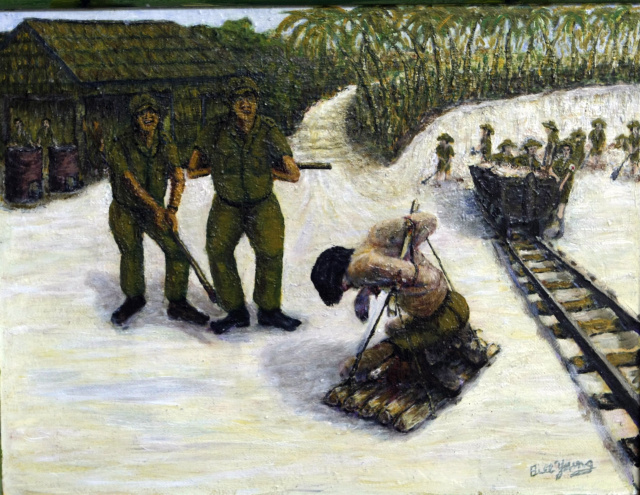 Bill Young
Bill Young
The torture of Jimmy Darlington, Sandakan February 1943
9 March. The last few days have been spent writing the captions for the photographs. There'll be something like 26 photos over 16 pages, a very generous spread. I sent the copy to Melbourne and Bob seemed pleased. A last minute trip to Yass to get a photo of Harry Longley, Billy's best mate, from his brother Gerald Longley. Harry died at Ranau after the death marches from Sandakan in 1945. We knew his family from the days when we ran our antique shop at Yass and Bowning in the 70s and 80s. Past and present are always meeting. The photographs are arriving from the institutions such as the Australian War Memorial, the Auckland War Museum and the City of Sydney Archives. It's always exciting to see those years of work coming together at last in book form. I showed the edited pages and photo sections to Bill in Sydney a week ago. Even he now believes it will soon be a reality!
26 March. The first set of page proofs arrived in the mail today, a thick bundle of some 420 pages. It will be a solid book. Clear the dining room table and cover it with a cloth. Sharpen pencils. Clean the rubber. And sit down to start reading. It's a strange feeling, as always, to see one's typescript actually in print formatted onto the page. What has been an intensely personal creation - one's offspring in a very real sense - now starts to take on a life of its own, separate from the self. The proofs seem very clean, with only a few minor word changes, stylistic in consistencies and typos to correct; but otherwise the tale reads very well, almost as if it had been written by somebody else.
31 March. An email from SuzanneWilson in New Zealand to say that she's received her proofs and begun reading them. She likes what she's read so far. We've agreed to revert to the style of writing out the numbers from one to ninety-nine and noted a few other stylistic matters to be seen to for consistency. How to print song titles, or set lines of verse. That sort of thing. I went to Sydney for tomorrow's antique market, and met Bill at an afternoon meeting of The Sandakan Family. I showed him the proofs, and he's trilled, naturally, to see his book in print. Reality is getting closer. A couple of important matters arose during the meeting in relation to the award to Gunner Cleary (murdered at Ranau) which I will need to amend in the last chapter and also the Endnotes. The historian Lynette Silver was there, and it was good I had the proofs to show her. Also Sheila Bruhn, who wrote The Diary of a Young Girl in Changi. We were close during the writing of my book Animal Heroes, and in fact Sheila gave me the contact with John Lewis, of Sandakan Family, that led directly to my finding Billy's phone number. A lovely day meeting old friends, all of whom are looking forward to the new book.
3 April. I've send my second lot of corrections to Suzanne, and her email in response affirms she'll incorporate them when she's completed her reading. The message ends:' I am about halfway through, so back to the pile now! Not that it's a chore - it's a delight going through it actually, all the better because I haven't read it before and it is all so fresh and compelling.' I told her that her reponse, in the words of the old carol, 'brings tiding of comfort and joy' to the writer.
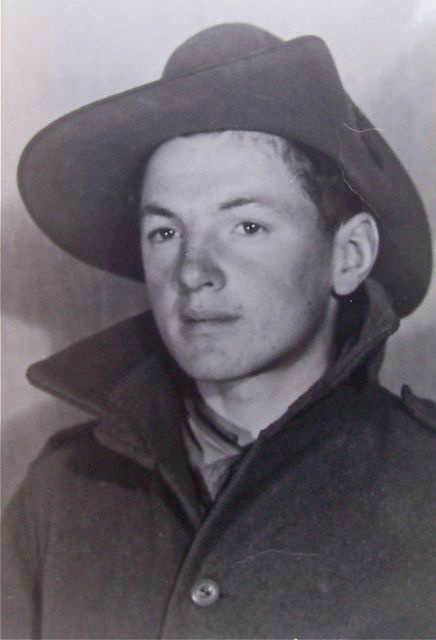 11 April. Today is the deadline for deliving the proofs back to Penguin. We've been in Melbourne for Easter and I've been completing them ... a task made infinitely more difficult by the illness and sudden death on Monday of my dear sister. A time of much loss and grief. Penguin kindly offered more time. But as Vanessa's funeral is tomorrow, I felt it better to keep to the original schedule before the reality of what has happened sets in. It was a good meeting with Bob Sessions and Adrian Potts who is the in-house editor supervising production of the book in place of Anne Rogan. I've been concerned about copyright on the few lines of poetry (apart from Billy's own verse) quoted in the book ... Kipling, Paterson ... As far as I could ascertain they're in the public domain, but I wasn't sure. Bob reassured me on the point. He also thinks we should have an index, which I agree. I've neither the time nor the skill to do it myself, however. Penguin will have it done and charge the cost (around $1000!) to the author's royalty account. The book had better sell!!
11 April. Today is the deadline for deliving the proofs back to Penguin. We've been in Melbourne for Easter and I've been completing them ... a task made infinitely more difficult by the illness and sudden death on Monday of my dear sister. A time of much loss and grief. Penguin kindly offered more time. But as Vanessa's funeral is tomorrow, I felt it better to keep to the original schedule before the reality of what has happened sets in. It was a good meeting with Bob Sessions and Adrian Potts who is the in-house editor supervising production of the book in place of Anne Rogan. I've been concerned about copyright on the few lines of poetry (apart from Billy's own verse) quoted in the book ... Kipling, Paterson ... As far as I could ascertain they're in the public domain, but I wasn't sure. Bob reassured me on the point. He also thinks we should have an index, which I agree. I've neither the time nor the skill to do it myself, however. Penguin will have it done and charge the cost (around $1000!) to the author's royalty account. The book had better sell!!
Bll Young, the 15-year-old soldier.
22 April. The email correspondence continues every couple of days with Adrian on last minute additions, amendments and tweaking: deciding on the best layout for the lines of verse, titles and placement for the maps, sending and incorporating the few words I want printed in Japanese characters, the Dutch rule for spelling the name van Hemert or Van Hemert. I must be driving Adrian mad with my small concerns, especially the need to spell out 'two and a half thousand brothers' in the last few pages. I'll buy him a drink when this is all over.
30 April. The second set of page proofs arived today by PDF, hard copy being sent by post. I printed the pages out and sat down to begin another reading - in some haste, for all corrections have to be in by the end of the next week, and I'm going up to Tweed Heads to spend a few days with my aunt after Vanessa's death. The pages are very clean and the text reads well. Adrian and Suzanne have done a first-class job between them. Most of my corrections are simply to avoid repetitions of specific words or phrases used elsewhere - for artistic variation. The setting is very good and I've come across very few errors as such. I've been sending my amendments to Adrian progressively, the last of them on 7 May, before leaving for Coolangatta. My wife Jill has one set of proofs to read at home while I'm away, and I'm taking the second for yet another read through.
7 May. I had a joint telephone call with Alysha and Heidi, the two Penguin publicists who will be organising the publicity for the book. One important bit of news. The book is actually coming out on July 25 for an official August release - a month earlier than I anticipated! The 2/29th Battalion Association wants to arrange a function to celebrate the publication, for Billy is one of their members; and I'm hoping that we will be able to do something at the annual Sandakan Memorial Service at Burwood in Sydney in early August. The publication date will really suit this. We talked possible media interest, and I'll take Billy in to meet Heidi when I'm in Sydney next month. I think he'll be very good talent for radio interviews, and as one of our youngest POWs he has a story to tell. Heide sent a draft press release to look at. The old journalist in me suggested a few changes along the lines of the above, which she incorporated.

9 May. The PDF of the final cover proof arrived today, when I'm at Tweed Heads. Very happy. Ir's the first time I've seen the back cover. Cathy has a photo of Billy taken by John Feder, so that we see him at 15 and at 85. The blurb looks OK, but it's always difficult to tell when you've had to write your own puff. The best thing is that Cathy's put a few strands of barbed wire running diagonally across the upper part of the back cover and the spine. It's a clever device. We know exactly what the book's about.
11 May. Last minute panic. The indexer has finished her work and likes the book, but has found one error. I refer to Lady Edwina Mountbatten, which is strictly not correct. Properly she was known as Lady Louis Mountbatten, which sounds strange to modern Australian ears. I agreed to call her by the correct title first time, but thereafter Lady Mountbatten or Edwina Mountbatten will have to do. I'm writing a novel, not a new edition of Debrett's.
Private John 'Becky' Sharpe, released POW 1945, by Bill Young (photo John Feder)
18 May. The last working day on the text. We go to the printer on Monday. Relief and terror all at once. Any errors now will be immortalised in ink - at least until we can correct them if there's another printing, which let the gods of poor authors permit! A few additions during the week: there are a few blank pages at the end now that the index is in. I suggested we use some of the advertisments for my other books taken from Captain Cook's Apprentice and Animal Heroes. Soldier Boy in particular will be very relevant to the readers of Billy Young. I hope the book becomes known by the short title of Billy Young, or just Billy. I've always called it that in my own mind, and if it comes naturally I hope it will stick in the public mind as well. Monday. The long production haul is almost over.
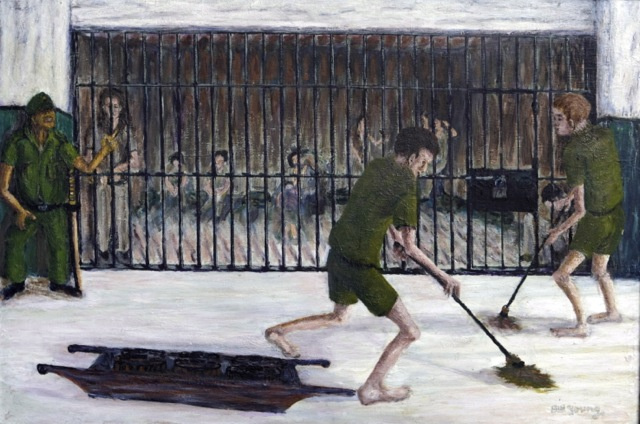
The death cells, Outram Road Prison, by Bill Young (photo John Feder)
31 May. I'm down in Melbourne doing a school visit to the Year 9 students at Xavier College, mainly talking about Soldier Boy, but I also took the opportunity to tell them a little about Billy Young. There was a good deal of interest in it too ... after all these young men at 15 were the same age as Billy when he enlisted. I went to Penguin afterwards, for they're just down the road at Camberwell, and had coffee with Adrian and also Cathy Larsen, who is leaving and will take up a freelancing career. It's a sign of tough times in the publishing business. Staff are becoming fewer. But Cathy is so good as a designer and artist, I've no doubt she'll find the work coming in.
7 June. Oh dear. I've finished reading the page proofs for yet another time. All was going well ... not a single error did I find. And then I came to the second last chapter. Four errors from there until the end of the book. Not major, but irritating. One a factual mistake on numbers caused by my misreading a source. Another arising from an oversight during the editing in the Chapter Notes ( but I think readers will realise the slip), and another couple of typos. I rang Adrian full of remorse. Never mind. He thinks he may have picked a couple of them up himself. And the rest we can amend when (and if) we get to a second printing. I'll send my corrections through when I go through it again. Adrian will put them on file for the reprint. He tells me the reports in from the reps are very positive. There's a lot of interest. We'll have to see if it translates into sales!
12 June. A drive to Sydney in pouring rain yesterday, to meet up with Billy and Heide McCourt, the Penguin publicist, today. It was a good meeting. We went through several proposals for promotional activities based around the publication on 22 July. The 2/29th Battalion Association is putting on a function at the State Library of Victoria on 26 July, and there is the annual Sandakan Commemoration Service in Sydney in early August. A few other suggestions for press, radio and perhaps television, but we'll see what comes of it. Billy is amazing. We walked up through a break in the weather from Martin Place to Surry Hills. He's as sprightly as a ... I was going to say 70 year old. But I turned 70 on 24 May, and God knows the old chap was out-pacing me up Elizabeth Street.
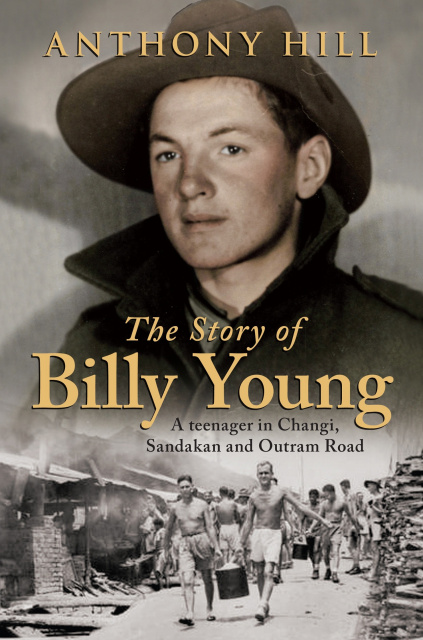
14 June. Well, a golden day. Quite literally. Permission has come through from Penguin for me to put the cover image on my website. And talking to Adrian in Melbourne today about a PDF image of the book spine for me to use as a bookmark, he tells me that the yellow writing on the cover will in fact be gold foil.
Gold foil! Good God! Just like a Jacki Collins best-seller. I've never had my name in gold foil before. It looks as if Penguin reckons that we might do well.
It's a lovely cover. Very strong. With strands of barbed wire going across the blurb at the back and the spine. I think it's one of the best that Cathy has done for any of my books.
And if any student of literature out there is reading these notes, let me advise you never to believe the adage 'Don't judge a book by its cover'. Quite frankly that's rubbish. People judge books by their covers all the time. It's why publishers put so much work into trying to get them just right and as appealing as possible to the market.
26 June. Email from Bob Sessions. "I've just received my advance copy of The Story of Billy Young - and no doubt yours will arrive shortly. It has come together very well indeed, and is a good looking book in every way. The flow of photos works well and the cover is attractive. Above all, it reads very well of course. Congratulatiuons Tony! Bob." So it's arrived at the publisher, hot off the press. A nagging day or two until my own copy arrives.
29 June. Actually it's been a nervous three days. But the first copies arrived in the mail today, and I'm a very happy man. The book is far better than I could have hoped. It's not the smaller paperback size as I'd anticipated, but a larger format - a 'trade paperback' they call it. The quality of the printing, photos, typeface and so on is far superior. And I think the words stand up as well. I began reading the text, and quickly found myself absorbed in the tale. Others will judge it; but it's remarkable how one's work takes on an independent life of its own once it appears between covers in book form. Like any offspring, it separates from the parent and assumes its own identity. Of course it has to be nurtured at first, succoured into wellbeing But with any luck it grows, and thrives until it reaches a point, like Soldier Boy, where the authorship is quite incidental to its existence.
1 July. In Sydney for the monthly antique and collectables fair. I visited Billy yesterday and gave him his first copy. I don't think I've seen anybody more quietly pleased, his whole life validated in print. We sat and talked and admired the fruit of our joint labours for an hour or two. It's been nearly six years since Win Adams gave me the idea at my market stall - almost five years since I first spoke to Bill. A long time, but worth every minute of it. He afterwards told me he'd started reading the book as soon as I left on Saturday, but had to stop several times. 'It gets close to the bone, doesn't it.'
2 July. Email to Bob Sessions. "Dear Bob. A note to let you know that my copies of Billy Young arrived [on Friday]. The book really does look a handsome production. You and the Penguin team have really done me proud. Personally I think this is the best book I've written; and the quality of your design, typography, layout, printing and editing has given it every chance to succeeed with the reading public. I hope they find the book as attractive as I do. Many sincere thanks indeed. Tony"
18 July. One week to go. Initial reaction has been pretty favourable from the media and other critics who I value, but it's very early days. Official publication is Wednesday 25 July, and Bill and I are going to Melbourne for a celebration seminar put on by the 2/29th Battalion Association at the State Library of Victoria. We'll be among friends for the kick off. The last few weeks have been very busy "tiding up": reviewing the tapes and transcripts of our interviews to offer to the Australian War Memorial; writing new material to put on the web site as we approach publication (including, importantly, an order form). And as this is the start of a new financial year, doing my tax. I've also been making arrangements for a trip to Gallipoli and Britain in October/November, to research a new book. The hiatus between receiving your first copies of a book and official publication is an touchy time for any author: very nervous for the new offspring on the one hand, hoping it will do well in the world - and on the other suffering a kind of sad post-partum depression. The child of one's fancy is no longer your own. The only antidote is work. Hence I'm busying myself on a new military project ... something from between the wars ... and am very gradually moving into that head space. I'm even getting a strong compulsion to clean out the kitchen cupboards: always a good sign that something new is on its way. It's called nest-building.
25 July. Publication day. Up early and to the airport to wait for Canberra's winter fog to lift and fly to Melbourne. I'm staying in a room next to Billy at a hotel in central Melbourne, close to our appointments. Billy did his first radio interview with a Melbourne station 3AW yesterday, and mine was this afternoon by phone with a north Queensland station that syndicates through Rockhampton, Mackay and Cairns. It's a bit of a strain, for we haven't yet got the patter down, but I stuck to the summary ideas in the Author's Note to the book, and we got through. Dinner at the hotel with my daughter Jane and Billy, with a good glass of wine to launch our little enterprise.
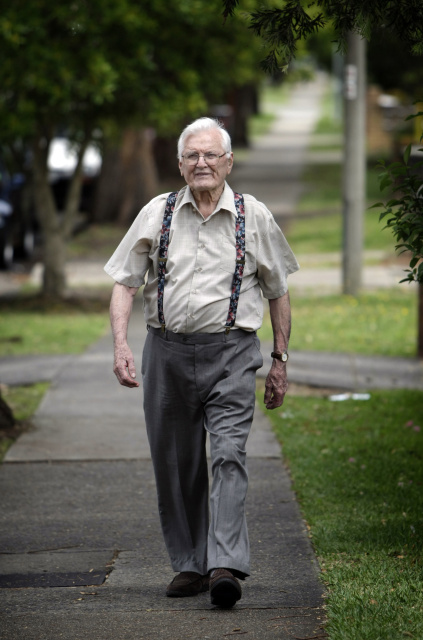 26 July. We walked up to the State Library of Victoria, where the 2/29th Battalion Association put on a splendid function to celebrate the book. We were among 80 or 90 friends, and Billy and I sat up on the stage talking about the book and the thoughts behind it with Associate Professor John Lack, who is now the Association's secretary and a great help to me during the writing. A joyful hour and a half. The images of some of Billy's paintings were screened across the wall behind us as we spoke, which added poignancy to the occasion, and I read the passage where, having been flogged senseless after his escape, the kid fancied he heard the Last Post being played, 'which spoke to him of something good and enduring; of friendships and values that mattered.' We signed a good many books afterwards (for one can never forget the commercial imperative), and had a noisy lunch in the Library restaurant (which is always the best way to celebrate anything).
26 July. We walked up to the State Library of Victoria, where the 2/29th Battalion Association put on a splendid function to celebrate the book. We were among 80 or 90 friends, and Billy and I sat up on the stage talking about the book and the thoughts behind it with Associate Professor John Lack, who is now the Association's secretary and a great help to me during the writing. A joyful hour and a half. The images of some of Billy's paintings were screened across the wall behind us as we spoke, which added poignancy to the occasion, and I read the passage where, having been flogged senseless after his escape, the kid fancied he heard the Last Post being played, 'which spoke to him of something good and enduring; of friendships and values that mattered.' We signed a good many books afterwards (for one can never forget the commercial imperative), and had a noisy lunch in the Library restaurant (which is always the best way to celebrate anything).
7 August. The end of two extraordinary weeks in Melbourne and Sydney. I think our book is going to be a success. We've had wonderful coverage in the press, and remarkable interest in the story from the radio stations. And (again with the commercial imperative in mind), I've had a constant stream of sales of The Story of Billy Young through my website: 70 books in a fortnight, almost as many as I sold for the last financial year! I hope it's being replicated in the shops. We're in Big W and Kmart; and although it's too soon to get precise figures, something seems to be happening in the market.
Bill Young in Sydney, 2011, Photo John Feder.
Billy is a natural for the radio. The microphone loves him, and of course he's the one people want to hear. His sincerity, gentleness, openness and the emotional dynamic of the story comes across in every word. We did a fine double interview for Radio Australia in Melbourne, which ended with Bill's remarkably generous view (for an ex-POW) of the Japanese people today and his desire to understand where, in their character and history, the horrors of the Second World War prison camps came from. A few days later, Richard Stubbs interviewed us on the ABC afternoon programme for 40 minutes! We both got rather teary speaking of the death of Pieter in the cell alone on the kid's lap. Marvellous live radio though, the inner self kept telling me; and afterwards we were told the program took listeners' calls to discuss the interview for another half hour. Richard spoke very favourably about the book, and the calls apparently were all very positive.
In Sydney, Richard Glover spoke to Billy for 15 minutes, just after we'd had an hour's stroll around Ultimo (something we'd always promised ourselves), visiting the kid's old haunts, and the interview glowed with the past. So much so they have asked Billy back to do a 30 minute interview for Armistice Day. We had over 30 minutes at drive time with Sydney radio 2GB, where we were all in high spirits. And on a double phone interview with a Brisbane station the other day, Billy finished up by singing a song. In Malay. Afterwards he told me that he had been taught it by MP Brown sitting in the cages at Kuching, awaiting their trial and sentence after escaping from Sandakan. I sent an email to the producer suggesting they do a 'back-announce' to tell that to the listeners. I've been talking to Billy for five years now, and still I'm learning new things about him.
The press to date has been very favourable to the book. The Sun-Herald gave three tabloid pages to an extract of the book (the section dealing with the escape) on Sunday 29 July, and the Sunday Age gave it a whole broadsheet page. Both came complete with photographs and reproductions of Bill's paintings of Sandakan and Outram Road. An entirely self-taught artist he may be, but the emotional force comes through, especially the painting of the torture of Jimmy Darlington and the self-portrait of Billy sitting cross-legged in Cell 72 at Outram Road prison. I felt the power of the pictures the first time I saw them; and it's good to find that others feel the same. They look very powerful in the newspapers; and my dear friend Jane Tanner, the artist, reacted in exactly the same way. Ian McPhedran did an interview with Bill which appeared in the Sydney Telegraph, was picked up by the Adelaide Advertiser and online, and led to the Brisbane interview.
Only one review of the book has appeared in print to date. Christopher Bantick spoke well of it in the Hobart Mercury. '... This splendid book' he calls it and goes on to remark: 'This is a book that is sure to have an impact on anyone who reads it. It is a timely and necessary book.'
Which are nice words by somebody else on which to end these diary notes on the production of a book. It's almost six years since Mrs Win Adams came to my market stall in Canberra and said, 'You should write a book about my husband's cousin Bill.' Nearly five years since I made that first phone call to Billy. We've been engaged on this campaign now for longer than the Second World War. As I say, I feel now that the book will be a succes: but ultimately that is for others to judge and it's best now to let The Story of Billy Young, a teenager in Changi, Sandakan and Outram Road find its own proper place in the world without my public commentary.
Still, one thing is for certain. The sheer amount of interest in the book over this past fortnight has been enough to ensure that Billy Young, his story, and the stories of his mates and the dear Dead End Kids of Sandakan, are no longer a matter of local knowledge. They are known now nationally, and have entered those halls where the names of those who have forged our country's military history are writ large and will be forever honoured.
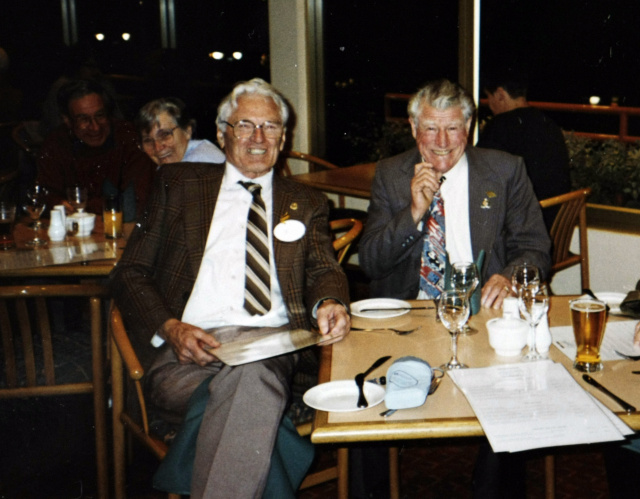
Bill Young (left) and Paddy O'Toole, his great mentor from the 2/29th Battalion, in later life.
Postscript:
15 August. Anniversary of the end of the Second World War. I heard today from the publisher that The Story of Billy Young has been the third highest selling non-fiction book in Australia in the first two weeks following its publication. It will indeed now find its own proper place in the world.
And one last postscript:
23 August. Email from Adrian: "Hi Tony. Some more cheering news: we're reprinting 1500 copies of Billy Young due to the strong demand. I'll take in all the corrections you've sent me so far. Let me know if you have anything else - though I need to get the reprint through by tomorrow midday. Sorry for the short notice! We don't get much heads up with reprints."
I have one small additional change ... just a textual repetition that was bothering me. But who really cares if there's no heads-up at all. We've gone to reprint after only four weeks! The Story of Billy Young is doing just fine.
6 September. Further email from Adrian: "Tony, another reprint is in the offing. 2K this time. Good news!"
I'll say! The second in the six weeks since publication.
Anthony Hill
Canberra 2012.
http://www.anthonyhillbooks.internetbasedfamily.com/billypromo.html